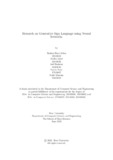| dc.contributor.advisor | Mostakim, Moin | |
| dc.contributor.advisor | Shakil, Arif | |
| dc.contributor.advisor | Alam, Md. Golam Rabiul | |
| dc.contributor.author | Selim, Bushra Binte | |
| dc.contributor.author | Iqbal, Maliha | |
| dc.contributor.author | Shahriar, Asif | |
| dc.contributor.author | Faria, Fauzia | |
| dc.contributor.author | Mostafa, Rafid | |
| dc.date.accessioned | 2021-09-04T10:14:00Z | |
| dc.date.available | 2021-09-04T10:14:00Z | |
| dc.date.copyright | 2021 | |
| dc.date.issued | 2021 | |
| dc.identifier.other | ID 21141052 | |
| dc.identifier.other | ID 21141050 | |
| dc.identifier.other | ID 16301040 | |
| dc.identifier.other | ID 17141007 | |
| dc.identifier.other | ID 16101069 | |
| dc.identifier.uri | http://hdl.handle.net/10361/14969 | |
| dc.description | This thesis is submitted in partial fulfillment of the requirements for the degree of Bachelor of Science in Computer Science and Engineering, 2021. | en_US |
| dc.description | Cataloged from PDF version of thesis. | |
| dc.description | Includes bibliographical references (pages 41-44). | |
| dc.description.abstract | Sign gesture, which is one type of non-audible specialized strategy is the medium
to correspond with individuals having auditory and talking incompetency. There
are numerous computerized methods of creating gesture-based communication to
provide aid among the hearing impaired. Particularly, for Bengali sign dialect, quite
a few measures have been taken for generation of automated Bangla sign gestures.
With an authentic dataset and approach, an apparent communication mode to assist
this non-privileged community can be attained. Our method proposes a convolutional neural network (CNN) to derive a picture of the appropriate sign gesture of
a particular Bangla alphabet. After our examinations and multiple experiments,
we have come up with the simplest and most striking methodology to perform the
mentioned task. Our model worked promptly and provided remarkable accuracy.
Needless to mention that, communication through gestures aided by artificial means
is another corner that needs to be explored more. Henceforth, our work can have
an added value to this ongoing inspection. | en_US |
| dc.description.statementofresponsibility | Bushra Binte Selim | |
| dc.description.statementofresponsibility | Maliha Iqbal | |
| dc.description.statementofresponsibility | Asif Shahriar | |
| dc.description.statementofresponsibility | Fauzia Faria | |
| dc.description.statementofresponsibility | Rafid Mostafa | |
| dc.format.extent | 44 pages | |
| dc.language.iso | en | en_US |
| dc.publisher | Brac University | en_US |
| dc.rights | Brac University theses are protected by copyright. They may be viewed from this source for any purpose, but reproduction or distribution in any format is prohibited without written permission. | |
| dc.subject | Sign Language Generation | en_US |
| dc.subject | Neural Network | en_US |
| dc.subject | Neural Networks for Sign Language | en_US |
| dc.subject | Generative Sign | en_US |
| dc.subject | CNN | en_US |
| dc.subject | Inceptionv3 | en_US |
| dc.subject.lcsh | Sign language. | |
| dc.title | Research on generative sign language using neural networks | en_US |
| dc.type | Thesis | en_US |
| dc.contributor.department | Department of Computer Science and Engineering, Brac University | |
| dc.description.degree | B. Computer Science | |

